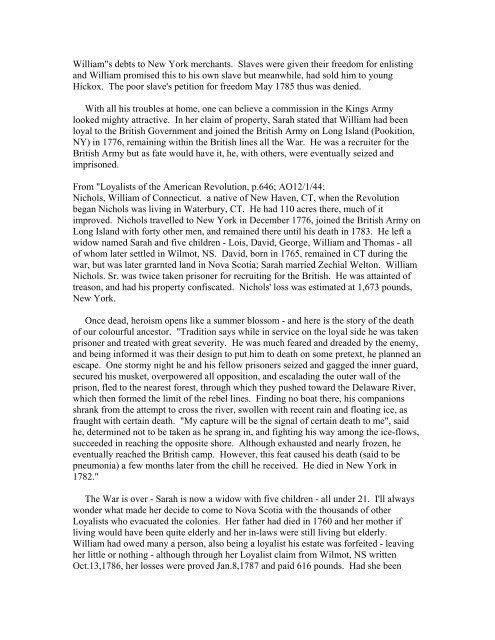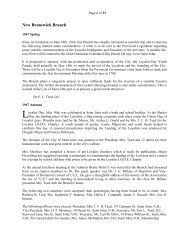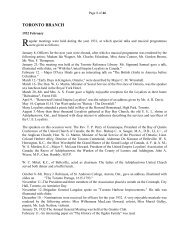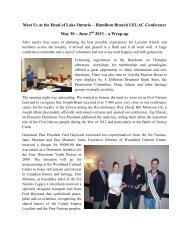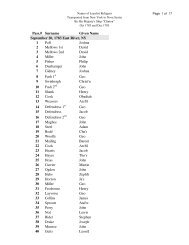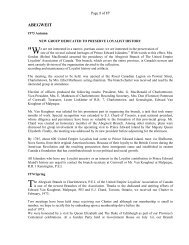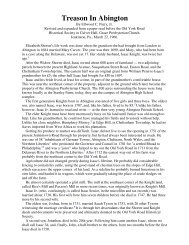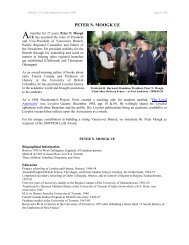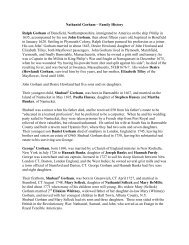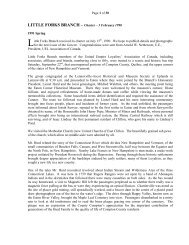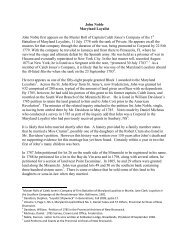BIOGRAPHY OF WILLIAM NICHOLS, LOYALIST NICHOLS LINE ...
BIOGRAPHY OF WILLIAM NICHOLS, LOYALIST NICHOLS LINE ...
BIOGRAPHY OF WILLIAM NICHOLS, LOYALIST NICHOLS LINE ...
You also want an ePaper? Increase the reach of your titles
YUMPU automatically turns print PDFs into web optimized ePapers that Google loves.
William"s debts to New York merchants. Slaves were given their freedom for enlisting<br />
and William promised this to his own slave but meanwhile, had sold him to young<br />
Hickox. The poor slave's petition for freedom May 1785 thus was denied.<br />
With all his troubles at home, one can believe a commission in the Kings Army<br />
looked mighty attractive. In her claim of property, Sarah stated that William had been<br />
loyal to the British Government and joined the British Army on Long Island (Pookition,<br />
NY) in 1776, remaining within the British lines all the War. He was a recruiter for the<br />
British Army but as fate would have it, he, with others, were eventually seized and<br />
imprisoned.<br />
From "Loyalists of the American Revolution, p.646; AO12/1/44:<br />
Nichols, William of Connecticut. a native of New Haven, CT, when the Revolution<br />
began Nichols was living in Waterbury, CT. He had 110 acres there, much of it<br />
improved. Nichols travelled to New York in December 1776, joined the British Army on<br />
Long Island with forty other men, and remained there until his death in 1783. He left a<br />
widow named Sarah and five children - Lois, David, George, William and Thomas - all<br />
of whom later settled in Wilmot, NS. David, born in 1765, remained in CT during the<br />
war, but was later grarnted land in Nova Scotia; Sarah married Zechial Welton. William<br />
Nichols. Sr. was twice taken prisoner for recruiting for the British. He was attainted of<br />
treason, and had his property confiscated. Nichols' loss was estimated at 1,673 pounds,<br />
New York.<br />
Once dead, heroism opens like a summer blossom - and here is the story of the death<br />
of our colourful ancestor. "Tradition says while in service on the loyal side he was taken<br />
prisoner and treated with great severity. He was much feared and dreaded by the enemy,<br />
and being informed it was their design to put him to death on some pretext, he planned an<br />
escape. One stormy night he and his fellow prisoners seized and gagged the inner guard,<br />
secured his musket, overpowered all opposition, and escalading the outer wall of the<br />
prison, fled to the nearest forest, through which they pushed toward the Delaware River,<br />
which then formed the limit of the rebel lines. Finding no boat there, his companions<br />
shrank from the attempt to cross the river, swollen with recent rain and floating ice, as<br />
fraught with certain death. "My capture will be the signal of certain death to me", said<br />
he, determined not to be taken as he sprang in, and fighting his way among the ice-flows,<br />
succeeded in reaching the opposite shore. Although exhausted and nearly frozen, he<br />
eventually reached the British camp. However, this feat caused his death (said to be<br />
pneumonia) a few months later from the chill he received. He died in New York in<br />
1782."<br />
The War is over - Sarah is now a widow with five children - all under 21. I'll always<br />
wonder what made her decide to come to Nova Scotia with the thousands of other<br />
Loyalists who evacuated the colonies. Her father had died in 1760 and her mother if<br />
living would have been quite elderly and her in-laws were still living but elderly.<br />
William had owed many a person, also being a loyalist his estate was forfeited - leaving<br />
her little or nothing - although through her Loyalist claim from Wilmot, NS written<br />
Oct.13,1786, her losses were proved Jan.8,1787 and paid 616 pounds. Had she been


